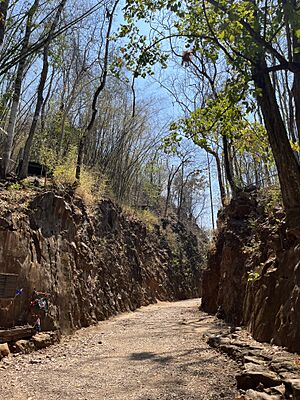Hellfire Pass facts for kids
| ช่องเขาขาด | |

A portion of Hellfire Pass in 2023
|
|
| Lua error in Module:Location_map at line 420: attempt to index field 'wikibase' (a nil value). | |
| Established | 24 April 1996 |
|---|---|
| Location | Kanchanaburi Province, Thailand |
| Type | War memorial, nature trail & abandoned railway line |
| Public transit access | Nam Tok Sai Yok Noi railway station (18 km (11 mi) away) |
Hellfire Pass (called Chong Khao Khat in Thai) is a special place in Thailand. It is a deep cut through rock that was made for a railway line. This railway was built during World War II by people who were forced to work.
This railway was known as the "Death Railway." More than 250,000 people from Southeast Asia and 12,000 Allied soldiers built it. Hellfire Pass was part of this railway. It got its name because the workers suffered terribly. They worked by torchlight, and it looked like a scene from Hell.
Contents
The Story of Hellfire Pass
Hellfire Pass is in the Tenasserim Hills. It was a very hard part of the railway to build. It was the biggest rock cutting on the whole line. The area was also very far away, and there were not enough proper tools.
Building a tunnel might have been easier. But a cutting could be worked on from many places at once. This meant the Japanese could make the prisoners work faster. Australian, British, Dutch, and other Allied prisoners were forced to work 18 hours a day. They had to finish the cutting quickly.
During the six weeks it took to build, 69 men were beaten to death by Japanese guards. Many more died from sicknesses like cholera and dysentery. They also suffered from starvation and extreme tiredness. Most deaths happened among Asian workers. They were tricked into coming with promises of good jobs. These workers, mainly from Malaya, suffered just as much as the prisoners of war.
The railway was not built to last forever. The Royal Air Force often bombed it during the war. After the war, most of the railway was closed. Today, trains only run on a small part of it, between Bangkok and Nam Tok Sai Yok Noi.
Hellfire Pass Today
No trains run on the Hellfire Pass section anymore. The closest train station is at Nam Tok Sai Yok Noi. From there, you can take a train to Kanchanaburi. This trip goes over the Wang Pho Viaduct and the famous bridge over the River Kwai. Kanchanaburi is the main town for visitors to the Hellfire Pass area.
Remembering the Past: The Museum
The Hellfire Pass Memorial Museum helps us remember what happened there. It started in 1983 when a former prisoner of war, J.G. (Tom) Morris, visited the area. He wanted the Australian government to save parts of the railway as a historical site.
Because of his efforts, a survey was done in 1984. The first special ceremony was held at Hellfire Pass on Anzac Day in 1990. The museum was built by the Office of Australian War Graves. It was opened by the Prime Minister of Australia, John Howard. The museum is supported by the Royal Thai Armed Forces and the Australian government. It helps remember the suffering of those who built the railway.
The Hellfire Pass Interpretive Centre was updated in 2018. It has information and displays about how the Death Railway was built. It also shows the suffering and sacrifices made. The museum has videos, old items, and a memorial for those who died. You can walk through the cutting and along part of the old railway track. You can also listen to an audio tour. This tour includes stories from prisoners who survived.
Hintok: A Nearby Camp
Hintok was an area just past Hellfire Pass. It was where the land started to go uphill. The railway needed to climb slowly here. There were four camps at Hintok. These included camps for British, Australian, and Dutch prisoners. There was also a mountain camp led by Weary Dunlop. This camp even had a bamboo fence to keep tigers away!
The first prisoners arrived in January 1943. Their job was to clear the forest and build the camps. By March 1943, about 800 prisoners were living there.
Beyond Hellfire Pass, there was a "Three-Tiered Bridge." This was a trestle bridge built to gain height. Another very tall trestle bridge, 25 meters high, was called the "Pack of Cards Bridge." It collapsed three times while being built. Because of this, it was later replaced with a raised dirt path instead.
In June 1943, a terrible outbreak of cholera happened at the Hintok mountain camp. It killed 57 Australian prisoners. Also, 31 prisoners died during the collapses of the Pack of Cards Bridge. Another 29 died because of the guards' cruelty. The bridges were finished in August 1943. The Three-Tiered Bridge was often photographed after the war. Today, it is hidden in the jungle.
Images for kids







